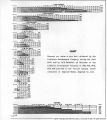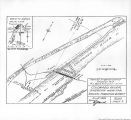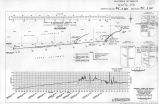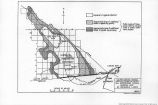| OCR Text |
Show 46 THE AUi-AMERICAN CANAL. On the entire canal stretch of about 10.5 miles through the sandhill area, the canal will have to be cut deep into the mesa formation. This mesa formation underlies the sand everywhere. Its surface is smooth, with definite moderate slope from northeast to southwest. The canal, where it leaves the sand-hill area a few hundred yards to the northward of the watering station at the west end of the plank road, will be in a cut about 40 feet in depth. Its water surface will be 25 feet below the surface of the mesa. Its course will be slightly south of west from this point, with gradual approach to the international boundary. As an alternative proposition, consideration has been given to a canal through the sand-hill area of smaller cross section, with higher velocity and with bottom and sides lined with concrete. The disadvantage of this alternative lies in the fact that the ultimate area to be irrigated by the canal must be taken into account at the time of construction, because when once constructed there can not well be any enlargement of a concrete-lined canal which must be kept in operation without interruption of service. The advantage of the lined canal lies mainly in the high velocity at which the water will be carried, thereby making sure that any sand and silt which gets into the canal will lodge elsewhere than in that portion of the canal in the sand-hill area, where the canal is deepest in the ground and where the removal of the sand would therefore be more difficult than from other portions of the canal. A lined canal would be only about 70 feet wide on the bottom, its gradient would be about 0.00017, the velocity when flowing full would be about 6 feet per second, and its bottom would be from nothing to 6 feet lower than that of an unlined canal. Less excavation by about 6,000,000 cubic yards would be required in its construction, but the saving in cost from this reduction in yardage would be about offset by the cost of the concrete lining. For further information on this subject reference should be had to the report of Mr. Preston, the engineer in charge of surveys. At about 6 miles to the westward of the sand hills the canal will be out of deep cut and a proposed mesa canal can there be supplied with water. At this point it is proposed to turn out for use on the mesa and lands to the northward 3,000 second-feet of the canal flow. The remainder, or about 6,000 second-feet, will be dropped 24 feet through a near-by power house at mesa power station No. 1, located about 4 miles west. About 3 miles westerly from this power station a low-level mesa canal, with a capacity of 500 second-feet, will be taken off and the remaining 5,500 second-feet will be held available for use in Imperial Irrigation District and on the west-side lands. |
| Source |
Original book: [State of Arizona, complainant v. State of California, Palo Verde Irrigation District, Coachella Valley County Water District, Metropolitan Water District of Southern California, City of Los Angeles, California, City of San Diego, California, and County of San Diego, California, defendants, United States of America, State of Nevada, State of New Mexico, State of Utah, interveners] : California exhibits. |




































































































































































































































































































































































































